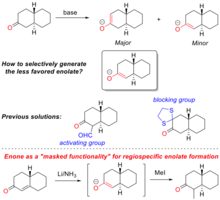Enone


An enone, also called an α,β-unsaturated carbonyl, is a type of organic compound consisting of an alkene conjugated to a ketone.[1] The simplest enone is methyl vinyl ketone (butenone) or CH2=CHCOCH3. An enal is the corresponding α,β-unsaturated aldehyde, an example being acrolein (CH2=CHCHO).
Synthesis
Enones are typically produced using an Aldol condensation or Knoevenagel condensation. Some commercially significant enones are produced by condensations of acetone, e.g. mesityl oxide and isophorone.[2]
In the Meyer–Schuster rearrangement the starting compound is a propargyl alcohol. Cyclic enones can be prepared via the Pauson–Khand reaction.

Reactions
Enones undergo many kinds of reactions.
They are electrophilic both at the carbonyl carbon but also at the β-carbon. Depending on conditions, either site is attacked by nucleophiles. Addition to the alkene is called conjugate additions. Michael additions are examples.
Enones are often good dienophiles in Diels-Alder reactions. They are activated by Lewis acids, which bind to the carbonyl oxygen.
Enones are readily reduced. They can undergo both reduction of the carbonyl and of the alkene (conjugate reduction), as well as both.
Enones undergo the Nazarov cyclization reaction and in the Rauhut–Currier reaction (dimerization).
Sterically unhindered enones such as methyl vinyl ketone are prone to polymerization.
Enones are good ligands for low-valent metal complexes, examples being Fe(bda)(CO)3 and tris(dibenzylideneacetone)dipalladium(0).
iron-tricarbonyl-2D-skeletal.png)
Related compounds
Enone is not to be confused with ketene (R2C=C=O). An enamine is a cousin of an enone, with the carbonyl replaced by an amine group.
Synthesis using regiospecific enolate formation and masked functionality

Regiospecific formation is the controlled enolate formation by the specific deprotonation at one of the α-carbons of the ketone starting molecule. This provides one of the best understood synthetic strategies to introduce chemical complexity in natural product and total syntheses. A prominent example of its use is in the total synthesis of progesterone illustrated in Figure "Regiospecific enolate formation in the total synthesis of progesterone".
When ketones are treated with base, enolates can be formed by deprotonation at either α-carbon. The selectivity is determined by both the steric and electronic effects on the α-carbons as well as the precise base used (see figure ""Masked functionality" for regiospecific enolate formation" for an example of this). Enolate formation will be thermodynamically favoured at the most acidic proton which depends on the electronic stabilization of the resulting anion. However, the selectivity can be reversed by sterically hindering the thermodynamic product and therefore kinetically favouring deprotonation at the other α-carbon centre. Traditional methods for regioselective enolate formation use either electronic activating groups (e.g. aldehydes) or steric blocking groups (e.g. 1,2-ethanedithiol protected ketone).
Enone (also known as α, β-unsaturated ketone) can also serve as a precursor for regiospecific formation of enolate, here the enone is a “masked functionality” for the enolate. This process is first described by Gilbert Stork[3] who is best known for his contributions to the study of selective enolate formation methods in organic synthesis.
The Stork method also uses enone as a “masked functionality” of enolate. Reacting enone with lithium metal generates the enolate at the α-carbon of the enone. The enolate product can either be trapped or alkylated. By using “masked functionality”, it is possible to produce enolates that are not accessible by traditional methods.
The “masked functionality” approach to regiospecific enolate formation has been widely used in total synthesis of natural products. For example, in the total synthesis of the steroid hormone progesterone,[4] Stork and co-workers used the “masked functionality” to stereospecifically construct one of the quaternary carbons in the molecule.
See also
References
- ↑ Smith, Michael B.; March, Jerry (2007), Advanced Organic Chemistry: Reactions, Mechanisms, and Structure (6th ed.), New York: Wiley-Interscience, ISBN 0-471-72091-7
- ↑ Hardo Siegel, Manfred Eggersdorfer "Ketones" in Ullmann's Encyclopedia of Industrial Chemistry, 2005, Wiley-VCH, Weinheim.doi:10.1002/14356007.a15_077
- ↑ Stork, G.; Singh, J., J. Am. Chem. Soc. 1974, 96, 6181.
- ↑ Stork, G.; McMurry, J. E., J. Am. Chem. Soc. 1967, 89, 5464.